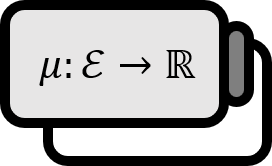Lebesgue Integration
Build-up
Before considering the generalization of the Riemann integral, it is necessary to define a simple function.
Assume that the function values are non-negative and the codomain of $\phi : \mathbb{R} \to \mathbb{R}$ is a finite set $\left\{ a_{1} , a_{2}, \cdots , a_{n} \right\}$. If $A_{i} = \phi^{-1} \left( \left\{ a_{i} \right\} \right) \in \mathcal{M}$ satisfies, then $\phi$ is called a simple function. Simple functions have the following properties:
- (i): If $i \ne j$, then $A_{i } \cap A_{j} = \emptyset$
- (ii): $\displaystyle \bigsqcup_{k=1}^{n} A_{k} = \mathbb{R}$
- (iii): $\displaystyle \phi (x) = \sum_{k=1}^{n} a_{k} \mathbb{1}_{A_{k}}(x)$ is a measurable function.
Here, $\mathbb{1}_{A}$ represents the indicator function.
Simple functions are inherently composed of three very manageable elements. Firstly, since the function values are non-negative, there is no need to consider the sign. Secondly, they are finite, allowing for free addition and subtraction. Thirdly, they are measurable. While the term simple is used in various ways across different fields of mathematics, in real analysis, it can certainly be considered the opposite of ‘complex.’ After defining such manageable and convenient simple functions, one can immediately think of a new integration that covers the Riemann integral.
Definition and Basic Properties
Lebesgue Integral of Simple Functions
When $\phi$ is a simple function and $E \in \mathcal{M}$, the following is called the Lebesgue integral of the simple function $\phi$.
$$ \int_{E} \phi dm := \sum_{k=1}^{n} a_{k} m (A_{k} \cap E) $$
The Lebesgue integral of a simple function possesses the following properties:
- [1]: For all $a>0$, $\displaystyle \int_{E} a \phi dm = a \int_{E} \phi dm $
- [2]: For two simple functions $\phi , \psi$, if $\phi \le \psi$, then $\displaystyle \int_{E} \phi dm \le \int_{E} \psi dm$
- [3]: If $A, B \in \mathcal{M}$ and $A \cap B = \emptyset$, then $\displaystyle \int_{A \cup B} \phi dm = \int_{A} \phi dm + \int_{B} \phi dm$
Here, $m$ denotes the Lebesgue measure. The condition of being a simple function is so strong and specific that it cannot be utilized in many places. By incorporating the idea of the partition method, a satisfactory ‘Lebesgue integral’ is formulated.
Lebesgue Integral of Measurable Functions 1
When $\phi$ is a simple function, and for the non-negative measurable function $f$ and $E \in \mathcal{M}$, the following is termed the Lebesgue integral of the measurable function $f$. $$\int_{E} f dm := \sup \left\{ \left. \int_{E} \phi dm \ \right| \ 0 \le \phi \le f \right\}$$
The Lebesgue integral of a measurable function is characterized by these properties:
- [1]’: For all $r \ge 0$, $\displaystyle \int_{E} r f dm = r \int_{E} f dm$
- [2]’: For two measurable functions $f, g$, if $f \le g$, then $\displaystyle \int_{E} f dm \le \int_{E} g dm$
- [3]’: If $A, B \in \mathcal{M}$ and $A \cap B = \emptyset$, then $\displaystyle \int_{A \cup B} f dm = \int_{A} f dm + \int_{B} f dm$
- [4]’: If $A, B \in \mathcal{M}$ and $A \subset B$, then $\displaystyle \int_{A} f dm \le \int_{B} f dm$
- [5]’: If $N \in \mathcal{N}$, then $\displaystyle \int_{N} f dm = 0$
- [6]’: $\displaystyle m(E) \inf_{E} f \le \int_{E} f dm \le m(E) \sup_{E} f$
Besides these basic properties, the following widely utilized theorem is introduced.
Theorem
For the measurable space $( X , \mathcal{E} )$ and the measurable function $f \ge 0$ and all measurable sets $A \in \mathcal{E}$, $$ \int_{A} f dm = 0 \iff f = 0 \text{ a.e.} $$ Here, $\text{a.e.}$ signifies almost everywhere.
Proof
$( \implies )$
For $E := f^{-1} ( 0 , \infty)$, if $m(E) = 0$, $f$ is almost everywhere $f=0$. For proof, assume $\displaystyle E_{n} := f^{-1} \left[ {{1} \over {n}} , \infty \right)$, then $\displaystyle E = \bigcup_{n=1}^{\infty} E_{n}$ and $\displaystyle \lim_{n \to \infty} E_{n} = E$ hold true. Considering the simple function $\displaystyle \phi_{n} := {{1}\over {n}} \mathbb{1}_{E_{n}} \le f$, $$ {{1}\over {n}} m( E_{n} ) = \int_{A} \phi_{n} dm \le \int_{A} f dm = 0 $$ therefore $$ {{1} \over {n}} m(E_{n}) \le 0 $$ that is, for all $n \in \mathbb{N}$, $m(E_{n}) = 0$ holds.
Meanwhile, since $E_{n} \subset E_{n+1}$, the following holds. $$ m \left( \bigcup_{n=1}^{\infty} E_{n} \right) = \lim_{n \to \infty} m (E_{n}) = m(E) = 0 $$
$( \impliedby )$
Since $f$ is almost everywhere $f=0$ and the simple function $\phi$ satisfies $0 \le \phi \le f$, $\phi$ is also almost everywhere $\phi = 0$. Hence, $\displaystyle \int_{A} f dm = 0$.
■
Capinski. (1999). Measure, Integral and Probability: p77. ↩︎
